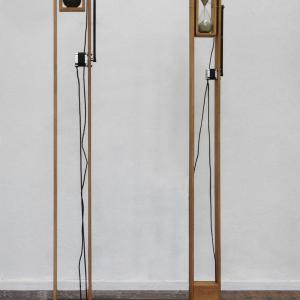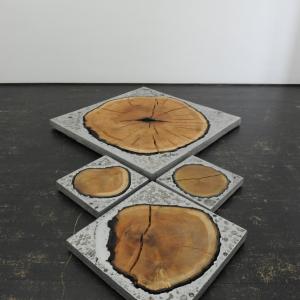Reality is Uncertain
1. Introduction
“Over the last centuries, humankind has put processes in motion leading to developments for which we no longer have any standards by which to judge them. When humankind itself becomes a natural force - or that which we understood to be nature is now made by humans – then the dualism of nature/culture subject/object no longer function in the accustomed fashion.” - Bernd M. Scherer, Textures of the Anthropocene - Using radioactivity as a guiding theme, I have explored how human beings have permanently changed the planet. Hovering at the interface of science and art—my work and site specifc installations deal with this realm of the Anthropocene—mans’ creation and utilisation of nuclear elements and hence the radioactive residue this has inevitably left on both nature and the societal psyche.
2. Concept
The proposed installation Project - Reality is uncertain - is the site-specic arragement of four (A,B,C,D) fractals that show different aspects related to man´s radioactive imprint on the planet inviting the visitors to contemplate in the environment of the intallation thus making the non perceivable more explicit.
The installation - Reality is uncertain - will be site-specifically arranged at the venue.
A) Imprint Series : Invisible imprint, Inverted invisible Imprint, Domarring
Invisible Imprint:
The work Invisible Imprint uses the radioactive potential of uranium minerals arranged in a ritualistic way as a tool to create apparent and persistent symbols of mankind. Radioactivity leaves visible traces on photosensitive material, a process which historically refers to the accidental discovery of radioactivity by Henry Becquerel. In the production of the work, radioactive minerals from all continents of the world have been repeatedly arranged and re-positioned on top of photosensitive paper for over a period of 30 days with different exposure times, resulting in blurry shadow traces that overlap and create a form reminiscent of a sun disc. Invisible Imprint combines the iconographic symbol of the sun and relates it to the ambivalent but yet intentional enthusiasm of the excessive use of radioactive material in the age of the Anthropocene. From the moment the first nuclear bomb was detonated, radioactivity has been fixed in the human eye as an explosion akin in strength and heat to that of the sun – as bright and as strong as a thousand suns. This association with the sun, the Earth’s primary source of energy, mirrors the inverse source of energy that emanates from Earth’s fi ssionable material assets, generated millennia ago by the cataclysmic death of other stars trapped in Earth's crust. Invisible Imprint calls to mind the fact that the human eye no longer exists as an icon of absolute proof and has lost its claim as a trustworthy source that can perceive that which is all around.
Inverted invisible imprint:
Like Invisibel Imprint, Inverted invisible Imprint uses the techinque of an autoradiographic process and formally references the symbol of the sun, but leaving a blanc white circular field - like a non phsiological blind spot on the retina that is created by looking to long into the sun you are invited see the peripherie but the center seems to be lost.
Domarring:
The autoradiography series Domarring shows overlapping radioactive shadows (radioactive Imprints) that are merging into ring like structure. The shadows where created with radioactive material from all active majoruranium mines on the globe. The title Domarring is a historical referrence to stone circles - yet to be speculated what pupose they might have had.
Size : 183 x 183 x 9 cm (each)
B) Containment I-IV Series
Containment consists of four discs of an 180 year old oak that was cut down in the area of Chernobyl that where moulded in hot Aluminium.
Size : 320 x 200 x 10 cm
C) Umkehr
Umkehr consists of two hourglasses filled with crushed silica that was formed on-site during the first two nuclear tests in history: 1946 at the Trinity Test Site in New Mexico and 1949 at the Polygon Test Site in Semipalatinsk, Kazakhstan (former Soviet Union). During the testing the extreme heat derriving from the nuclear events caused the sand at the sites to be transformed into glass. Remnants of this glass, also known as Trinitite or Kharitonchik, has been taken from each test site and pulverised, with the resulting fraction from each location allocated to one hourglass. The two timepieces rotate automatically in a composed manner, driven by a stepper motor connected to a gear wheel. The sound of the falling material resonating with the glass walls of the vessels is captured by microphones and played back using eight speakers mounted in the corners of the room. Each hourglass has four speakers projecting their sound; the sound traveling at intervals from left to right and from right to left. Imagine a nuclear explosion, the floor beneath you transformed to glass, little drops of cooled molten sand hailing down on you: The sound of the beginning of the nuclear age.
Size : 120 x 120 x 180 cm
D) Encounter:
Encounter is comprised of twelve windowpanes made of polymer dispersed liquid crystal glass (PDLC). As rays emanating from the radioactive decay processes of the surrounding space hit the window panes, the events are detected with Geiger-Mueller tubes located at the bottom of each window pane. The tranparency of the glass is altered from translucent to opaque for a short moment of time, reverting back to its original state. As the interconnected components are inherently fl exible, the object can be installed in myriad ways. The subtle, intimate aesthetic experience addresses the boundaries of the viewers' perception, and brings the rays and their source into an illusive focus, provoking ambivalent connotations.
Size : 580 x 280 x 80 cm

































Comments 0
Say something